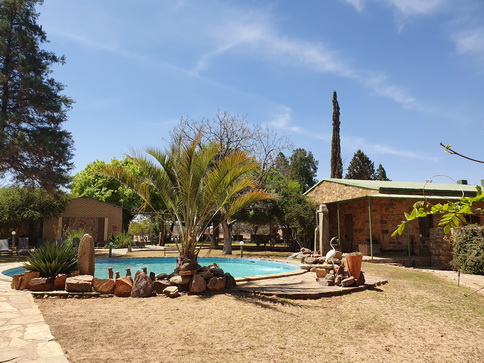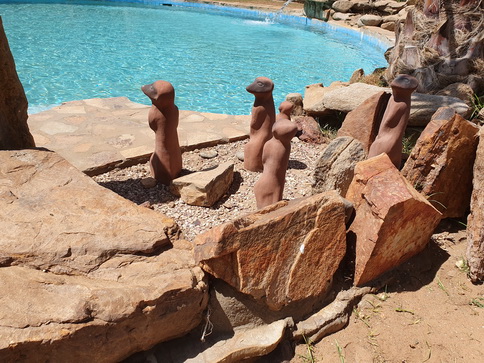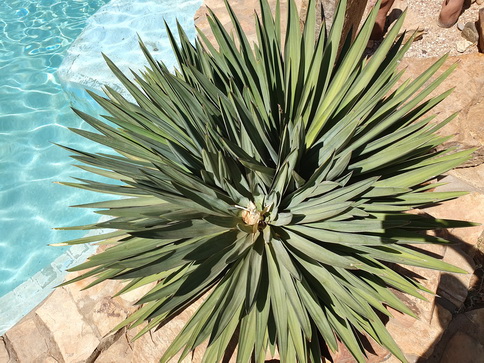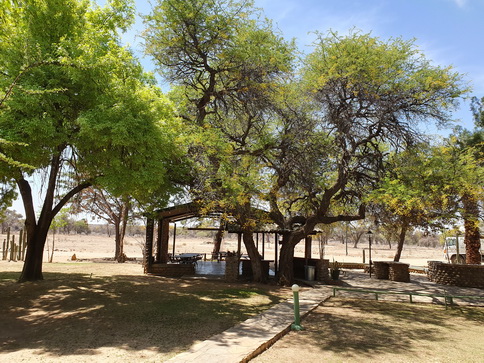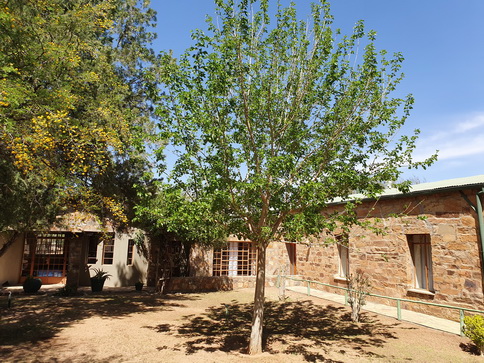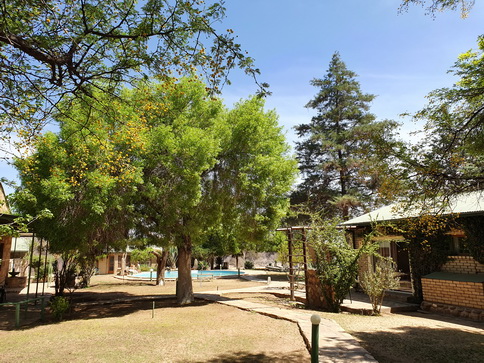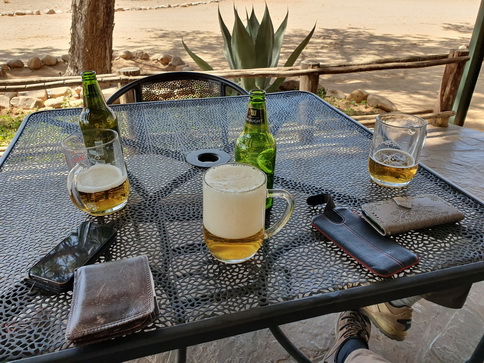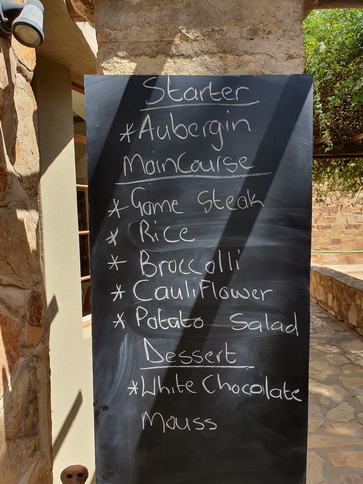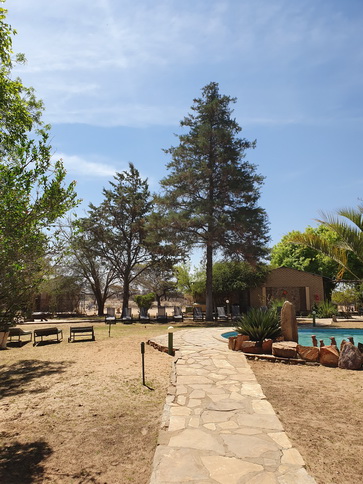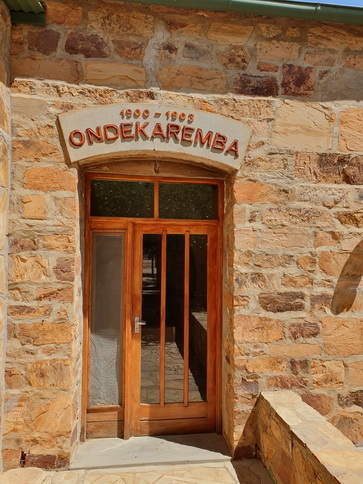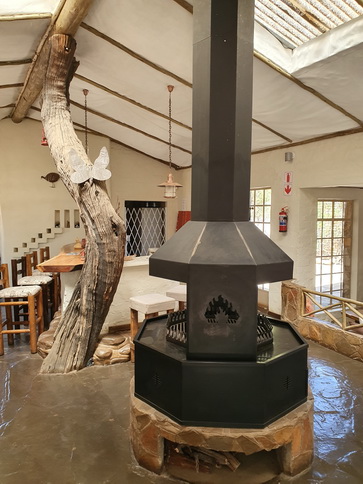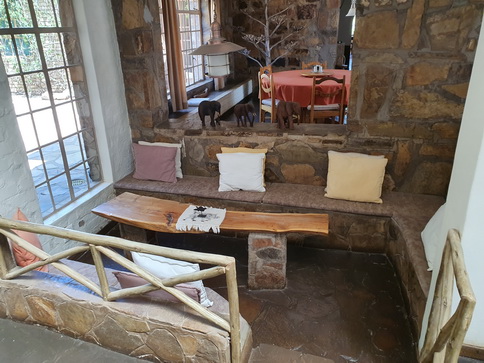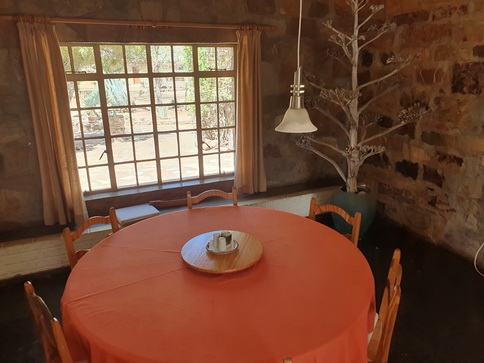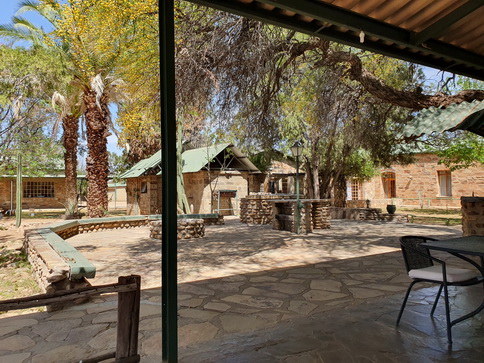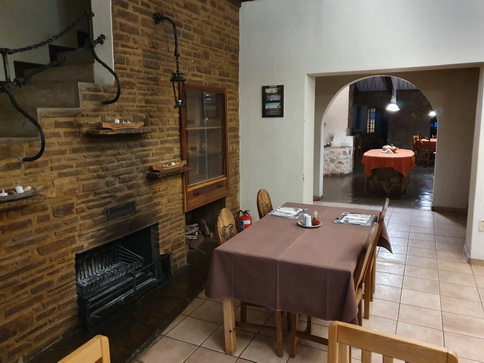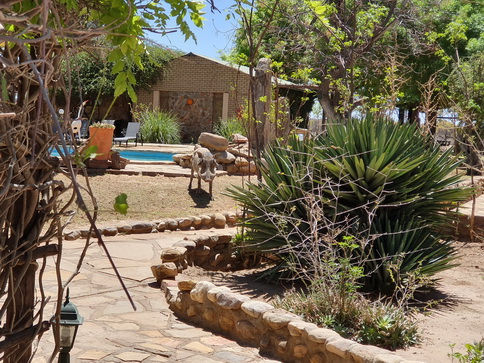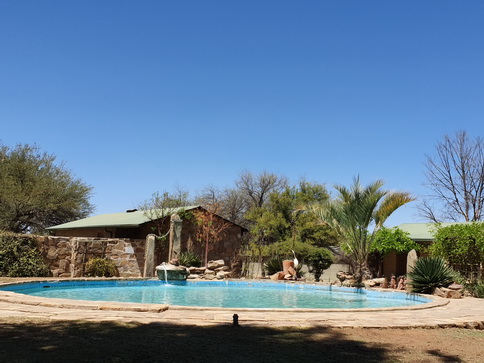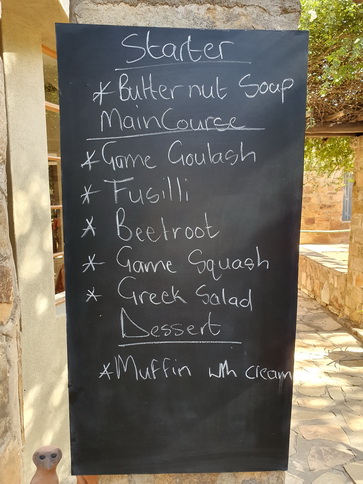Das
Khomas Hochland ist eine
Region im
Zentralen Namibia, die vor
allem durch ihre
bergige Landschaft und ihre
natürliche Schönheit
bekannt ist. Die Region gehört zur
Khomas Region, in der sich
auch die Hauptstadt
Windhoek befindet. Diese
Hochlandregion umfasst ein
bedeutendes geografisches Gebiet,
das viele landschaftliche Merkmale
wie Hügel, Berge und Täler aufweist.
Geografie und Landschaft:
-
Das
Khomas Hochland liegt
westlich von Windhoek
und erstreckt sich bis in den
Osten des
Namibischen Hochlands.
Diese Region ist von
Bergen,
Hochebenen und
dichten Tälern geprägt.
-
Das Gebiet liegt etwa
1.500 bis 2.500 Meter
über dem Meeresspiegel und
bietet ein
subtropisches Klima mit
kühleren Temperaturen als in den
niedrigeren Regionen Namibias.
-
Zu den markanten geologischen
Merkmalen gehören die
Khomas-Hügel, die das
Hochland dominieren und sich
durch ihre
steilen Hänge und
felsenbedeckten Ebenen
auszeichnen.
Flora und Fauna:
-
Die Region ist von einer
Vielzahl von
vegetativen Zonen
geprägt, einschließlich
Halbwüsten,
Savannen und
Buschlandschaften. Der
Vegetationswuchs ist im
Allgemeinen eher spärlich, aber
es gibt viele
Akazien und
Buschwerk, die an das
trockene Klima angepasst sind.
-
Das
Wildleben im Khomas
Hochland umfasst verschiedene
Arten von
Vögeln,
Kleinsäugern und
gelegentlich größere Tiere wie
Antilopen. In den
höheren Lagen kann man auch
Bergzebras oder
Giraffen antreffen.
Wirtschaft und Landwirtschaft:
-
Das
Khomas Hochland ist
stark landwirtschaftlich
geprägt, insbesondere durch
Viehzucht,
Schafhaltung und
Ziegenzucht. Die
Regionen um Windhoek sind
bekannt für ihre
Viehzuchtbetriebe und
viele
Farmen produzieren
Fleisch und andere
landwirtschaftliche Produkte.
-
Tourismus ist ebenfalls
ein wichtiger Wirtschaftsfaktor,
da die Region aufgrund ihrer
malerischen Landschaft und Nähe
zu Windhoek viele Besucher
anzieht. Wanderungen,
Fahrten mit Geländewagen
und Besuche von
Naturreservaten sind
beliebte Aktivitäten.
Wichtige Orte und Sehenswürdigkeiten:
-
Windhoek:
-
Als Hauptstadt Namibias ist
Windhoek der zentrale
Knotenpunkt für das Khomas
Hochland und ein wichtiger
Zugangspunkt zu den
umliegenden Regionen.
Windhoek liegt im Tal der
Khomas-Hügel und ist von der
Hochlandregion umgeben.
-
Daan Viljoen Nature Reserve:
-
Ein Naturreservat im Khomas
Hochland, das etwa 20
Kilometer von Windhoek
entfernt ist. Es bietet
Besuchern die Möglichkeit,
wilde Tiere zu beobachten
und Wanderungen in der
Umgebung zu unternehmen.
-
GocheGanas Nature Reserve:
-
Etwa 30 km südlich von
Windhoek bietet dieses
Privatreservat eine tolle
Gelegenheit,
wild lebende Tiere
in ihrer natürlichen
Umgebung zu erleben und
Luxus-Lodges zu
genießen.
-
Gamsberg:
-
Ein beeindruckender
Berg im Khomas
Hochland, der bei Wanderern
und Naturliebhabern beliebt
ist. Die Gegend um den
Gamsberg ist für ihre
Trekkingmöglichkeiten
bekannt.
Klima:
-
Das Klima im Khomas Hochland ist
gemäßigt und kühler im Vergleich
zu den tiefergelegenen Gebieten
Namibias. Die Sommermonate sind
heiß, aber nicht so extrem wie
in den Küstenregionen oder in
den tieferen Tälern.
-
Regenfälle fallen
hauptsächlich im Sommer, von
November bis März, wobei die
Region in der Regel mit weniger
Niederschlag bedacht wird als
die feuchteren Regionen
Namibias.
Kulturelle Bedeutung:
-
Die Region hat auch kulturelle
Bedeutung, da sie in der Nähe
von
Windhoek liegt, das die
Hauptstadt und das politische
sowie wirtschaftliche Zentrum
des Landes ist.
-
Verschiedene
Namibische ethnische Gruppen
leben und arbeiten in und um das
Khomas Hochland, darunter die
Herero,
Damara und
Nama.
Fazit:
Das
Khomas Hochland bietet eine
faszinierende Mischung aus
beeindruckender Natur, wildem Leben
und landwirtschaftlicher Bedeutung.
Es ist sowohl für Abenteurer als
auch für Kulturinteressierte ein
attraktives Ziel und spielt eine
wichtige Rolle in der
wirtschaftlichen und touristischen
Entwicklung Namibias.
|
The Khomas Hochland (Khomas Highlands) is a picturesque and
mountainous region in central Namibia, surrounding the capital city of
Windhoek. Known for its stunning landscapes, rugged terrain, and rich
biodiversity, the Khomas Hochland is a popular destination for outdoor
enthusiasts and nature lovers. Here’s everything you need to know about
this unique area:
About the Khomas Hochland
Location:
The Khomas Hochland is located in the Khomas Region, just west of
Windhoek.
It forms part of the Great Escarpment, which separates
the central plateau of Namibia from the Namib Desert.
Geography:
The region is characterized by mountainous terrain, deep valleys,
and rocky outcrops.
It is part of the Namib-Naukluft Mountain
Range, with elevations ranging from 1,500 to 2,000 meters (4,900–6,500
feet) above sea level.
Climate:
The Khomas Hochland has a
semi-arid climate, with hot summers and cool winters.
Rainfall is
sparse, but the area is known for its dramatic thunderstorms during the
rainy season (November to April).
Things to Do in the Khomas
Hochland
Hiking and Trekking:
The region offers numerous
hiking trails, ranging from easy walks to challenging treks.
Popular trails include those in the Auas Mountains and Namib-Naukluft
Park.
Scenic Drives:
The C26 and D1461 roads wind through
the Khomas Hochland, offering breathtaking views of the mountains and
valleys.
The drive from Windhoek to the coastal town of
Swakopmund via the Khomas Hochland is particularly scenic.
Wildlife Viewing:
The area is home to a variety of wildlife,
including kudus, oryx, mountain zebras, and leopards.
Birdwatchers can spot species like the Monteiro’s hornbill and
Verreaux’s eagle.
Rock Climbing:
The rugged terrain and
rocky outcrops make the Khomas Hochland a great destination for rock
climbing and bouldering.
Photography:
The dramatic
landscapes, with their contrasting colors and textures, provide endless
opportunities for photography.
Cultural Experiences:
Visit
nearby Windhoek to explore Namibian culture, history, and cuisine.
Key Attractions in the Khomas Hochland
Auas Mountains:
A
mountain range southeast of Windhoek, offering excellent hiking and
stunning views.
Daan Viljoen Game Park:
Located just
outside Windhoek, this park is part of the Khomas Hochland and is home
to wildlife like zebras, giraffes, and antelopes.
Gamsberg Pass:
A scenic mountain pass that offers panoramic views of the
surrounding landscape.
Namib-Naukluft Park:
While most of
the park lies further west, the eastern sections extend into the Khomas
Hochland, offering rugged beauty and solitude.
Where to Stay
The Khomas Hochland offers a range of accommodation options, from luxury
lodges to rustic campsites. Some popular choices include:
Amani
Lodge: A luxury lodge near Windhoek with stunning views of the Auas
Mountains.
Daan Viljoen Game Park Campsite: A budget-friendly
option for nature lovers.
Gamsberg Pass Campsite: A remote
campsite with basic facilities and incredible views.
Getting to
the Khomas Hochland
By Car: The Khomas Hochland is easily accessible
from Windhoek via well-maintained gravel roads. A 4x4 vehicle is
recommended for exploring remote areas.
By Air: The nearest
airport is Hosea Kutako International Airport, located about 40
kilometers (25 miles) east of Windhoek.
Best Time to Visit
The
best time to visit the Khomas Hochland is during the dry season (May to
October), when the weather is mild and wildlife is easier to spot.
The rainy season (November to April) brings lush greenery and
dramatic thunderstorms but can make some roads impassable.
Why
Visit the Khomas Hochland?
Natural Beauty: The rugged mountains, deep
valleys, and wide-open spaces are a feast for the eyes.
Outdoor
Adventures: Whether you’re hiking, climbing, or driving, the Khomas
Hochland offers endless opportunities for adventure.
Proximity to
Windhoek: The region is easily accessible from Namibia’s capital, making
it a great day trip or weekend getaway.
If you’re planning a trip
to the Khomas Hochland, let me know if you’d like more tips or
recommendations for activities and accommodations! |





